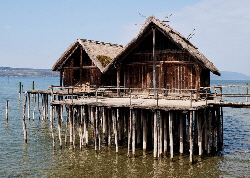|
a) History of the use of Iron in Dyeing
b) African Mud Cloth
a) History of the use of Iron in Dyeing
Metals are among the earliest dyes for textiles. In fact, ancient greys and blacks were almost all dyed with iron together with plant tannins. According to Liles, cottons and linens have been dyed to iron buff by placing the material in iron water springs or burying the material in wet, iron-containing mud often for a week or two.

Examples of this technique can be seen in the textiles of the Swiss Lake Dwellers (approximately 3000 BC), Egyptians also dyed with iron liquor and the sails of many Mediterranean fishing boats were dyed buff until quite recently.
Ferrous sulphate has also been known as ‘Copperas’ since ancient times and, despite the name, has nothing to do with copper. You might also see ferrous sulphate being referred to as ‘green vitriol’ in old dye books.
b) African Mud Cloth
The ancient technique of producing a black and tan design by treating a cotton cloth with tannin and iron is still used in Mali’s Bambara or Bamana culture to create the famous mud cloth, also known as bogolan.
First of all the fabric is treated in a bath made with leaves rich in tannin, which makes the fabric yellow. The design is then outlined with iron-rich mud and the background is filled in, leaving a mainly black background with white patterns. The fabric is washed and the process repeated. Finally the yellow areas are bleached.
The motifs used in the design are part of Mali’s Bogolanfini language. The motifs can refer to everyday objects like houses, locations, streams, or animals. Sometimes the motifs are used to illustrate a proverb or to share medical knowledge or local history.
a) What is the Iron sold for dyeing? (opens a new page)
b) Iron as a Dye Modifier (opens a new page)
c) Iron as a Mordant (opens a new page)
d) Dyeing with Iron (opens a new page)
e) History of Dyeing with Iron (this page)
f) African Mud Cloth (this page)
Top of Page
|